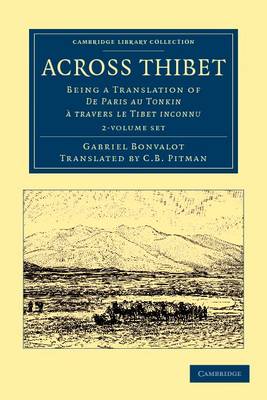Cambridge Library Collection - Travel and Exploration in Asia
3 primary works • 6 total works
Volume 1
The French explorer, author and legislator Gabriel Bonvalot (1853-1933) travelled widely in Central Asia in the 1880s. This two-volume English translation by C. B. Pitman of the 1889-90 French original was published in 1891. It describes Bonvalot's expedition across Europe and Asia to French Indochina. Accompanied by Prince Henri d'Orleans whose father, the Duc of Chartres, financed the expedition, Bonvalot left Paris in July 1889. In Volume 1, the expedition crosses first Russia and then Siberia, making its way south to Tibet. The obstacles encountered are considerable, with temperatures reaching 40 degrees below zero (Bonvalot describes how the fat that the expedition eats for butter is so hard that it may be 'used as a projectile') and altitude sickness affecting many of the party. The volume ends as the party enters Tibet, but without being certain exactly where they are.
Volume 2
The French explorer, author and legislator Gabriel Bonvalot (1853-1933) received funding from the French government to lead two expeditions to Central Asia in the 1880s. This two-volume English translation by C. B. Pitman of the French original was published in 1889 and is a richly illustrated account of the second of the two Asian expeditions, in which Bonvalot and the scientist Guillaume Capus attempted to enter Afghanistan. Although the party was detained and sent back to Samarkand upon entering Afghanistan, they refused to concede defeat, as Bonvalot was determined to reach India via a trail believed to run across the Pamir and Hindu Kush mountains. In Volume 2 the party reaches the remote Kingdom of Chatral, but is imprisoned again. Bonvalot uses the confinement to study the customs of the local people, and eventually, with the help of the British authorities, they are released and allowed to continue to India.
Volume 2
The French explorer, author and legislator Gabriel Bonvalot (1853-1933) travelled widely in Central Asia in the 1880s. This two-volume English translation by C. B. Pitman of the 1889-90 French original was published in 1891. It describes Bonvalot's expedition across Europe and Asia to French Indochina. Accompanied by Prince Henri d'Orleans whose father, the Duc of Chartres, financed the expedition, Bonvalot left Paris in July 1889. In Volume 2, the expedition succeeds in gaining formal permission to enter Tibet, despite the Lhasa government's usual policy of turning away foreigners. Bonvalot shows himself fascinated with the polyandry and polygamy practised by the Tibetans, saying that they seem 'quite contented with their lot, and gaiety reigns supreme'. The party continues through China's Yunnan province to Tonkin in northern Vietnam, and reaches Hanoi in 1890; they return to France by sea.
The French explorer, author and legislator Gabriel Bonvalot (1853-1933) received funding from the French government to lead two expeditions to Central Asia in the 1880s. This two-volume English translation by C. B. Pitman of the French original was published in 1889 and is a richly illustrated account of the second of the two Asian expeditions, in which Bonvalot and the scientist Guillaume Capus attempted to enter Afghanistan. Although the party was detained and sent back to Samarkand upon entering Afghanistan, they refused to concede defeat, as Bonvalot was determined to reach India via a trail believed to run across the Pamir and Hindu Kush mountains. In Volume 1, Bonvalot describes the journey from Marseille via Tehran to Samarkand, interspersing his narrative with observations of the climate and culture they encounter. At the Afghan border, guards warn that 'they will hack us to pieces and throw our bodies into the stream'.
The French explorer, author and legislator Gabriel Bonvalot (1853-1933) travelled widely in Central Asia in the 1880s. This two-volume English translation by C. B. Pitman of the 1889-90 French original was published in 1891. It describes Bonvalot's expedition across Europe and Asia to French Indochina. Accompanied by Prince Henri d'Orleans whose father, the Duc of Chartres, financed the expedition, Bonvalot left Paris in July 1889. The expedition travelled across Russia and south through Siberia to Tibet, encountering considerable obstacles, including temperatures reaching 40 degrees below zero and altitude sickness affecting many of the party. They obtained formal permission to enter Tibet despite the Lhasa government's policy of turning away foreigners, and Bonvalot was fascinated with the polyandry and polygamy practised by the Tibetans. The expedition continued to China's Yunnan province and Tonkin in northern Vietnam, reaching Hanoi in 1890; they returned to France by sea.
The French explorer, author and legislator Gabriel Bonvalot (1853-1933) received funding from the French government to lead two expeditions to Central Asia in the 1880s. This two-volume English translation by C. B. Pitman of the French original was published in 1889 and is a richly illustrated account of the second of the two Asian expeditions, in which Bonvalot and the scientist Guillaume Capus attempted to enter Afghanistan. Although the party was detained and sent back to Samarkand upon entering Afghanistan, they refused to concede defeat, as Bonvalot was determined to reach India via a trail believed to run across the Pamir and Hindu Kush mountains. Volume 1 describes the journey from France to Samarkand via Tehran, and the checkpoint at the Afghan border. In Volume 2 the party reaches the remote Kingdom of Chatral, but is imprisoned again. Eventually, the British allow the expedition to enter India.


